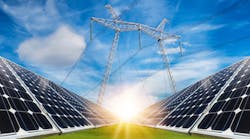Download this article in PDF format.
By 2035, solar energy may be powering 40% of the nation’s electricity, driving deep decarbonization of the grid and employing as many as 1.5 million people, all without raising electricity prices, according to a new report from the Department of Energy (DOE).
In its Solar Future Study, the DOE calls for massive and equitable deployment of clean energy sources, underscoring the Biden Administration’s efforts to tackle the climate crisis and rapidly increase access to renewable power throughout the country.
“The study illuminates the fact that solar, our cheapest and fastest-growing source of clean energy, could produce enough electricity to power all of the homes in the U.S. by 2035 and employ as many as 1.5 million people in the process,” said Secretary of Energy Jennifer M. Granholm, in a press release.
“Achieving this bright future requires a massive and equitable deployment of renewable energy and strong decarbonization policies,” Granholm continued, “exactly what is laid out in the bipartisan Infrastructure Investment and Jobs Act and President Biden’s Build Back Better agenda.”
A Record Amount of Solar
The DOE says that the US installed a record amount of solar—15 gigawatts (GWac)—to total 76 GW, representing 3% of the current electricity supply, in 2020. By 2035, it would need to quadruple its yearly solar capacity additions and provide 1,000 GW of power to a renewable-dominant grid.
By 2050, solar energy could provide 1,600 GW on a zero-carbon grid—producing more electricity than consumed in all residential and commercial buildings in the country today, the DOE predicts. And, decarbonizing the entire energy system could result in as much as 3,000 GW of solar by 2050 due to increased electrification in the transportation, buildings and industrial sectors.
Here are the various scenarios that have to play out in order for the nation to achieve a carbon-free electric grid by 2035 without increasing electricity prices:
- Achieving decarbonization requires significant acceleration of clean energy deployment, which will employ as many as 500,000–1.5 million people in solar jobs by 2035. Compared with the approximately 15 GW of solar capacity deployed in 2020, annual solar deployment is 30 GW on average in the early 2020s and grows to 60 GW on average from 2025 to 2030, according to the DOE. Similarly-substantial solar deployment rates continue in the 2030s and beyond. Deployment rates accelerate for wind and energy storage as well.
- Storage, transmission expansion and flexibility in load and generation are key to maintaining grid reliability and resilience. Storage capacity expands rapidly, to more than 1,600 GW in 2050. Small-scale solar, especially coupled with storage, can enhance resilience by allowing buildings or microgrids to power critical loads during grid outages. In addition, the DOE says that advances in managing distributed energy resources, such as rooftop solar and electric vehicles, are needed to efficiently integrate these resources into the grid.
- Expanding clean electricity supply yields deeper decarbonization. Electricity demand grows by about 30% from 2020 to 2035, owing to electrification of fuel-based building demands (e.g., heating), vehicles and industrial processes. Electricity demand increases by an additional 34% from 2035 to 2050. By 2050, all these electrified sectors are powered by zero-carbon electricity, and the electrification growth results in an emissions reduction equivalent to 155% of 2005 grid emissions.
- Land availability does not constrain solar deployment. In 2050, ground-based solar technologies require a maximum land area equivalent to 0.5% of the contiguous U.S. surface area. “This requirement could be met in numerous ways,” the DOE points out, “including the use of disturbed or contaminated lands unsuitable for other purposes.”
- The benefits of decarbonization far outweigh additional costs incurred. Cumulative power system costs from 2020 to 2050 are $562 billion (25%) higher, which includes the costs of serving electrified loads previously powered through direct fuel combustion. “However,” the DOE says, “avoided climate damages and improved air quality more than offset those additional costs, resulting in net savings of $1.7 trillion.”
Equitable Distribution
The DOE says some challenges must be addressed before solar costs and benefits can be distributed equitably. For example, it sees various interventions—financial, community engagement, siting, policy, regulatory and resilience measures—as the keys to improving equity in rooftop solar adoption.
“Additional equity measures can address the distribution of public and private benefits,” the DOE adds, “the distribution of costs, procedural justice in energy-related decision making, the need for a just workforce transition, and potential negative externalities related to solar project siting and disposal of solar materials.”
The DOE says that while a dramatically larger role for solar in decarbonizing the nation’s electricity system—and energy system more broadly—is within reach, this will only be possible through a “concerted policy and regulatory efforts as well as sustained advances in solar and other clean energy technologies.”










